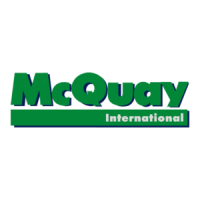
Do you have a question about the McQuay RAH 077C and is the answer not in the manual?
| Brand | McQuay |
|---|---|
| Model | RAH 077C |
| Category | Air Handlers |
| Language | English |
Location and details on the gas burner nameplate for units with gas heat.
Dangers, warnings, and cautions regarding hazardous situations and their consequences.
Shows typical unit locations of major components for general information.
Shows locations of various control components mounted throughout the units.
Describes unit control panels and their locations in typical unit configurations.
Lists unit control devices, their functions, locations, settings, and part numbers.
Instructions for inspecting equipment upon receipt for damage and completeness.
Details required service clearances around the unit for access and maintenance.
Minimum ventilation clearance recommendations for proper unit performance.
Restrictions for overhead obstructions above the unit and air handler section.
Instructions for locating, assembling, and installing the roof curb for unit support.
Instructions for installing IBC Seismic compliant units on roof curbs or post/rail.
Instructions for setting the unit on rails and welding it to the rails for support.
How to determine required lifting cable lengths and whether 4-point or 6-point lifting is needed.
Information on units shipped factory split for installation on the roof.
Details on field reassembly of a split RAH unit in three phases.
Information on field installation of refrigerant piping and charging DX coils.
Guidelines for pipe sizing, material, and installation for refrigerant systems.
Procedure for leak testing the refrigerant system before charging.
Steps for evacuating the refrigerant system to remove moisture and non-condensables.
Procedure for charging the system with refrigerant after leak testing and evacuation.
Details on connecting the condensate drain and ensuring proper drainage.
Information on piping for steam, hot water, and chilled water coils.
Instructions for steam coil piping, including connections and condensate removal.
Recommendations for steam piping flexibility, size, traps, and pitch.
Guidance on selecting and installing steam traps for proper condensate removal.
Recommendations for preventing steam coil freeze-up in cold conditions.
Information on chilled water coils, factory piping, and field connections.
Information on optional damper assemblies, actuators, and linkages.
Operation and linkage adjustment of economizer dampers.
Details on intake hood dampers for units requiring 100% outside air.
Information on intake hood dampers for fixed fresh air quantities (0-30%).
Description of the mixing box with outside and return air dampers for blending air.
Information on face and bypass dampers for flat or staggered arrangements.
Details on factory gasketing and caulking for weather resistance and field sealing.
Instructions for connecting ductwork, ensuring airtight connections and minimizing losses.
Procedure for field installing duct static pressure taps for VAV units.
Procedure for installing building static pressure sensor taps for pressurization control.
Instructions for field power wiring, conduit penetration, and grounding.
Information on circuit ampacity, wire sizing, voltage requirements, and phase balance.
Instructions for low voltage field wiring for control arrangements.
Initial steps before operating the unit, including fan mount checks.
Information on releasing and adjusting spring mounts for isolated fans.
Instructions for removing tie-downs from the relief damper for proper operation.
How to adjust scroll dampers for even air distribution between fans.
How to adjust thrust restraints on spring-mounted double-width fans.
Procedure for field adjusting seismic restraints on spring-mounted fans.
Describes the initial power-up sequence and how components are energized.
Sequence for supply and return fan startup and operation via VFDs.
How the economizer operates based on outdoor air enthalpy and temperature.
Explanation of the keypad/display layout, navigation, and page structure.
Information on accessing different password levels for controller settings.
How to navigate menus and pages using the keypad and wheel.
How to enter edit mode and change parameter values using the keypad.
Lists component IDs, descriptions, and their standard locations in the wiring diagrams.
Explains common symbols and conventions used in wiring diagrams.
Describes how actuators control dampers and valves using analog signals.
Explanation of the electromechanical enthalpy control device and its settings.
Details on the optional electric differential enthalpy control arrangement.
Explains the ground fault protection system for motors against arcing faults.
Describes the phase voltage monitor that protects against power line issues.
How to use an external time clock for unit scheduling or override.
Information on optional smoke detectors and their integration with unit controls.
How to use external components for unit emergency shutdown.
Details on the optional freezestat and its actions during freezing conditions.
How the unit responds to freezing conditions when fans are operating.
How the unit responds to freezing conditions when fans are off.
Methods for switching unit operation between occupied and unoccupied modes.
Information on available field output signals for connecting to external devices.
How to select and use the VAV or Fan Operation output signal.
Information on the EFT sensor and its role in preventing low airflow heating issues.
Function of the duct high pressure limit control (DHL) for over-pressurization protection.
Information on the GFCI receptacle and optional section lights.
Description of DesignFlow airflow measurement stations and their function.
Procedure for leveling the DesignFlow station vanes for accurate airflow measurement.
Covers maintenance and operating instructions for propeller exhaust fans.
Checks for fasteners, fan rotation, and motor load before operation.
Information on belt tension, alignment, and maintenance to prevent premature failure.
Instructions for inspecting, lubricating, and maintaining fan shaft bearings.
Importance of checking fasteners and setscrews for tightness to prevent damage.
Guidance on motor lubrication and the type of oil or grease to use.
How to clean motors and fans without damaging components.
How exhaust fans are controlled based on system pressure and damper position.
Provides troubleshooting guidelines for common exhaust fan problems.
Description of the UV light option for coil and drain pan sanitation.
Explains how UV lights operate based on power, switches, and door status.
Safety precautions when working on control panel components.
A checklist of items to verify before starting the unit.
Steps to safely power up the unit and check the control system startup sequence.
Procedure for starting up the supply and return fans and checking their operation.
Steps for starting up the economizer, checking damper positions and cooling calls.
General procedures for starting up heating systems (gas, electric, steam, hot water).
Performing air balancing, checking fan motors, and adjusting sheaves.
Instructions for verifying sheave alignment and torquing setscrews.
General rules for tensioning belts and measuring tension.
Steps for measuring belt tension using a checker.
Mounting and adjusting VM and VP variable pitch sheaves.
Adjusting MVP variable pitch sheaves for proper operation.
How to use the calibrate mode to zero pressure sensors and calibrate actuators.
Recommends recording setpoints and parameters for reference and replacement.
Safety precautions when working on control panel components.
Recommended routine maintenance items for system inspection and upkeep.
Precautions for storing the unit on the ground or in its final position.
Steps for preparing supply and return fans before operation after storage.
Monthly checks for moisture or debris accumulation in cabinet sections.
Procedure for closing gas shutoff valve and opening furnace control switch.
Recommendations for maintaining the control compartment environment.
Procedures for performing a complete start-up after extended storage.
Instructions for adding grease to fan motor bearings.
Details on lubricating supply and return fan motors.
Information on fan shaft bearing lubrication compatibility and frequency.
Step-by-step instructions for bearing installation or removal.
Detailed steps for checking and installing bearings in bolt-on housings.
Instructions for fitting and torquing BOA Concentric collars.
Checking bearings for noise/vibration and tightening devices after initial run.
Importance of checking setscrews for tightness to prevent equipment damage.
Special procedure for retightening return fan bearing setscrews for equal loading.
Procedures for winterizing water coils to prevent freeze-up and damage.
Information on manual motor protectors (MMPs) and their function.
Details on MMP features, trip points, and how to reset them.
Information on circuit breakers, their modes of operation, and how to reset them.
Instructions for using spring clamp terminals for field wiring.
Explains the PVM's function to protect loads from power line issues.
Recommended methods for accessing controls or disabling power to the unit.
How MicroTech III controller uses static pressure transducers and their output signals.
Procedure for troubleshooting suspect duct or building static pressure sensors.
Provides instructions for ordering replacement parts from McQuay.
Procedure for returning material under warranty for repair or replacement.
Lists exclusions and limitations to the product warranty.
How to obtain assistance or information regarding the warranty.
States the owner's sole remedy and disclaims other warranties and damages.
Checklist for initial inspection items before unit startup.
Section to record supply and return fan data during startup.
Checks and data recording for compressor startup operations.
Detailed section for recording compressor and fan performance data.
Checklist for electric heat system checks, tests, and startup.
Checklist for gas and oil burner system checks, tests, and startup.
Specific checks for gas burner operation, including input, pressure, and controls.
Specific checks for oil burner operation, including nozzle, pressure, and controls.
Instructions on recording and updating MicroTech III control parameters.
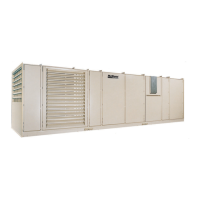
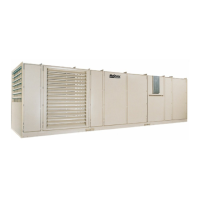






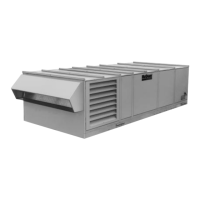
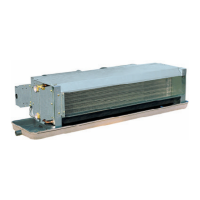
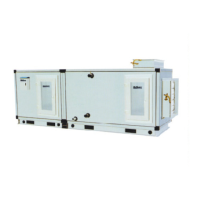

